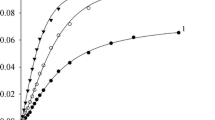Summary
The kinetics of the oxidation of sixp-substituted phenethyl alcohols (PEA, R=−H, −Cl, −Br, −CH3, −OCH3, and -NO2) by sodium-N-chloro-p-toluene sulfonamide (chloramine-T,CAT) in the presence of HCl was studied at 35°C. The rate shows a first order dependence on [CAT]0 and [H+]0 and a fractional order in [PEA]0 and [Cl−]0. Ionic strength variations, addition of reaction product toluene sulfonamide, and variation of the dielectric constant of the medium have no effect on the rate. The solvent isotope effect\(k_{H_2 0}^\prime /k_{D_2 0}^\prime \) amounts to about 0.90. Proton inventory studies have been made in H2O-D2O mixtures. The rates correlate satisfactorily withHammett's relationship. The reaction constant ρ was −3.3 for electron releasing substituents and −0.25 for electron withdrawing groups at 35°C. The activation parameters ΔH #, ΔS #, ΔG #, and logA were derived. ΔH # and ΔS # are linearly related, and an isokinetic relationship is observed with β=166.7K, indicating entropy as a controlling factor.
Zusammenfassung
Die Kinetik der Oxidation von sechsp-substituierten Phenethylalkoholen (PEA), R=−H, −Cl, −Br, −OCH3 und NO2) mit Natrium-N-chlor-p-toluolsulfonamid (Chloramin-T,CAT) in Gegenwart von HCl bei 35°C wurde untersucht. Die Reaktionsgeschwindigkeit ist in bezug auf [CAT]0 und [H+]0 ester und hinsichtlich [PEA]0 und [Cl]0 gebrochener Ordnung. Variation der Ionenstärke, Zusatz von Reaktionsprodukt oder Toluolsulfonamid und Variation der Dielektrizitätskonstante des Mediums haben keinen Einfluß auf die Reaktionsgeschwindigkeit Der Lösungsmittel-Isotopeneffekt\(k_{H_2 0}^\prime /k_{D_2 0}^\prime \) beläuft sich auf etwa 0.90. Die Protonenbilanz wurde in H2O-D2O Mischungen untersucht. Die Geschwindigkeiten korrelieren zufriedenstellend nach derHammettschen Beziehung. Die Reaktionskonstante wurde mit ρ=−3.3 für elektronenabgebende und ρ=−0.25 für elektronenanziehende Substituenten bei 35°C bestimmt. Die Aktivierungsparameter ΔH #, ΔG #, ΔG # und logA wurden abgeleitet; ΔH # und ΔS # korrelieren linear, und eine isokinetische Beziehung mit β=166.7K weist auf die Entropie als kontrollierenden Faktor hin.
Similar content being viewed by others
References
Campbell MM, Johnson G (1978) Chem Rev78: 65
Mahadevappa DS, Rangappa KS, Gowda NMM, Gowda BT (1981) J Phys Chem25: 3651
Mahadevappa DS, Ananda S, Murthy ASA, Rangappa KS (1984) Tetrahedron10: 1673
Mahadevappa DS, Mohan K (1985) Oxid Comm207: 86
Mythily CK, Mahadevappa DS, Rangappa KS (1991) Collect Czech Chem Commun56: 1671
For a review see: Haines AH (1988) Methods for the Oxidation of Organic Compounds. Academic Press, New York
Palomo C, Ontolia JM, Odriozola JM, Aizpurua JM, Ganboa I (1990) J Chem Soc Chem Commun 248
Wiberg KB (1965) Oxidation in Organic Chemistry, part A. Academic Press, New York, pp 142, 159;
Wiberg KB (1965) Oxidation in Organic Chemistry, part A. Academic Press, New York, pp 198;
Wiberg KB (1965) Oxidation in Organic Chemistry, part A. Academic Press, New York, pp 200;
Wiberg KB (1965) Oxidation in Organic Chemistry, part A. Academic Press, New York, pp 47;
Wiberg KB (1965) Oxidation in Organic Chemistry, part A. Academic Press, New York, pp 247
Trahanovsky WS (1973) Oxidation in Organic Chemistry, part B. Academic Press, New York, pp 35;
Trahanovsky WS (1973) Oxidation in Organic Chemistry, part B. Academic Press, New York, pp 197
Andette RJ, Quail JW, Smith PJ (1972) Chem Commun 38
Richards RME et al. (1969 and 1972) J Pharmacol21: 68 and24: 145
Morris JC, Salazar JA, Wineman MA (1948) J Am Chem Soc70: 12036
Mahadevappa DS, Ananda S, Gowda NMM, Rangappa KS (1985) J Chem Soc Perkin Trans 39
Ehrenson S, Brownlee RTC, Taff RW (1973) Prog Phys Org Chem10: 13
Gilliom RD (1970) Introduction to Physical Organic Chemistry. Addison-Wesley, London, p 264
Albery WJ, Davies MH (1972) J Chem Soc Faraday Trans68: 167
Gopal Krishnan G, Hogg JL (1985) J Org Chem50: 1206
Isaccs NS (1987) Physical Chemistry, Wiley, New York, p 275
Moelwyn-Hughes EA (1947) The Kinetics of Reaction in Solutions. Clarenden Press, Oxford
Laidler KJ, Eyring H (1940) Ann NY (Acad Sci39: 303;
Laidler KJ, Landskroener PA (1957) Trans Farady Soc52: 200;
Laidler KJ (1965) Chemical Kinetics. Tata-Mc Graw-Hill, Bombay
Benson SW (1960) The Foundation of Chemical Kinetics, Mc Graw-Hill, New York
Frost AA, Pearson RG (1961) Kinetics and Mechanism, 2nd ed. Wiley, New York
Amis ES (1966) Solvent Effects on Reaction Rates and Mechanisms. Academic Press, New York
Entelis SG, Tiger RP (1976) Reaction Kinetics in the Liquid Phase. Wiley, New York
Brown HC, Okamoto Y (1958) J Am Chem Soc80: 4979
Exner O (1964) Collect Czech Chem Commun29: 1094
Merck Index II, 7236
Beil11, 104
Author information
Authors and Affiliations
Rights and permissions
About this article
Cite this article
Ramachandra, H., Rangappa, K.S., Mahadevappa, D.S. et al. Oxidation of substituted phenethyl alcohols by sodium-N-chloro-p-toluene sulfonamide: A kinetic study. Monatsh Chem 127, 241–255 (1996). https://doi.org/10.1007/BF00813789
Received:
Accepted:
Issue Date:
DOI: https://doi.org/10.1007/BF00813789



